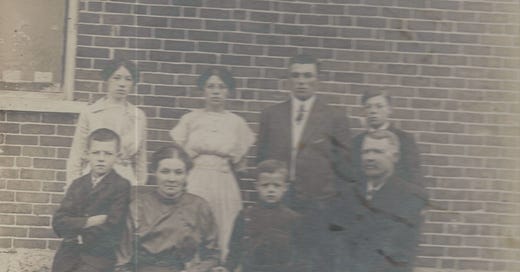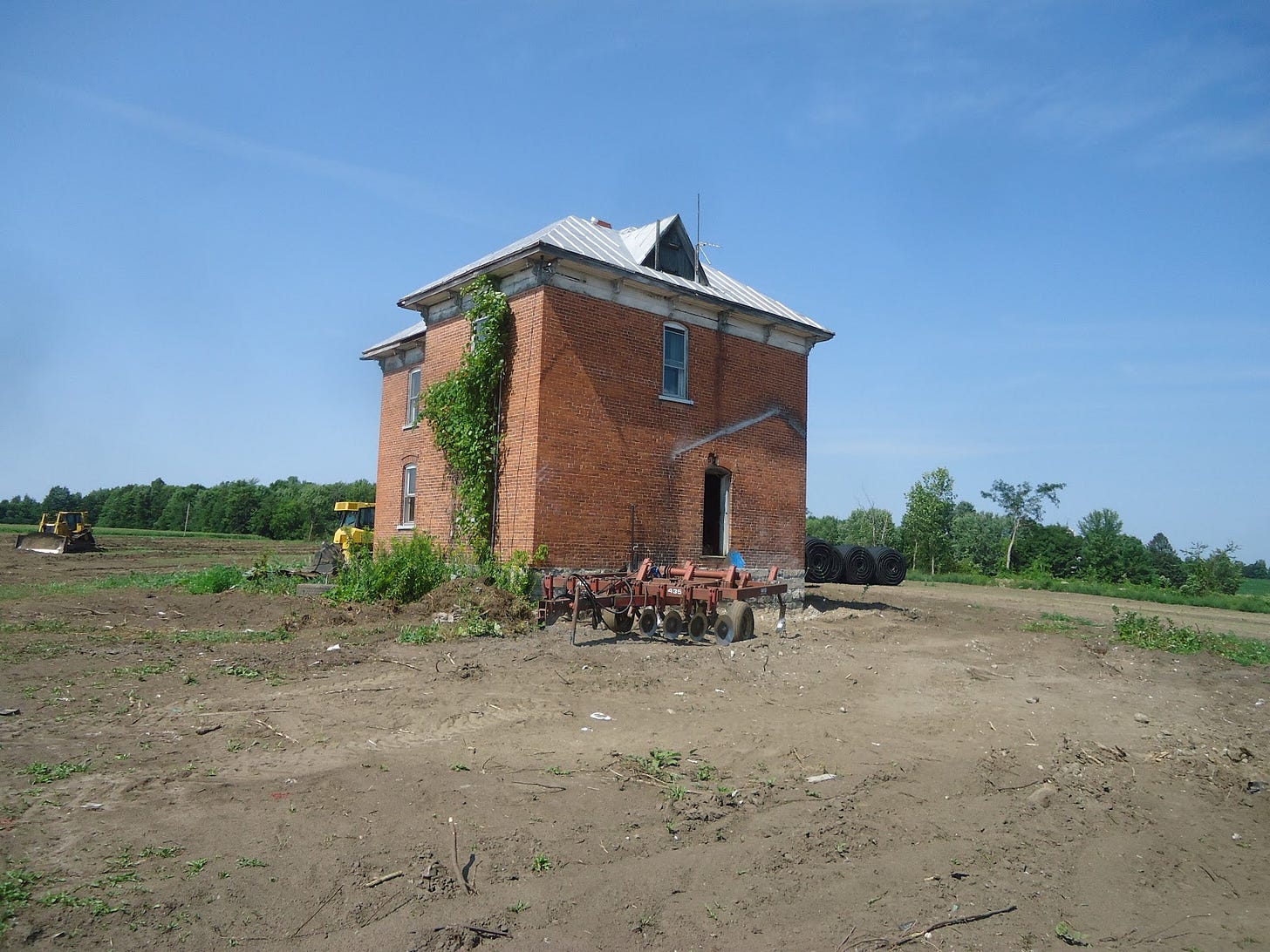the genealogy book
, the house my great grandparents, Finley John McLennan and Julia McRae, built,
My great grandfather, Finley John McLennan (1857-1938), was of the third generation of our particular settler McLennans in Canada West, yet of the first generation to be born beyond Scotland. Presumably born in Lancaster, Ontario, where his father, father’s siblings, and their parents first settled circa 1840, it was he who married Julia McRae (1862-1932) of the Swamp McRaes, Dyer Road, one concession road south of our Macdonald’s Grove. My great grandparents, Finley John and Julia, who built a red bricked square house on Lot 4, Concession 7 in 1880, the same year they married. The same year they were gifted the family bible that now sits in our basement, rich with births, baptisms and death notices. This two hundred acre lot in Roxborough Township he gained in 1873, at the death of his paternal uncle, Roderick McLennan. The land had been purchased by Roderick in 1860, fifteen years after possibly achieving the original land grant next door.
The Swamp McRaes. Oh, legendary Glengarry historian David G. Anderson (1946-2022) once said, quite excitedly, you’re related to the Swamp MacRaes. Living in the infamous Bethune-Thompson House in Williamstown, Anderson had spent decades as one of the staples of the Glengarry Historical Society, and somehow held all this information in his head, able to offer any of it at the drop of a hat. Alexander “Swamp” McRae (1829-1904), father of my great grandmother, Julia. Anderson never explained why he was so excited at the connection, or where the name emerged. Enough Alexander McRaes that one needed to distinguish between them, I’d suspect. Did he live in a swamp? The same property, I think, a concession road south, where the Vanderwielens landed from Europe to purchase farm property in Ontario the late 60s or early 70s. Who still farm the same land. Who eventually purchased the homestead fields from my father, around the time of his triple bypass surgery. Nine years after my father’s ill health forced him to retire the fields, and rent them out to those same neighbours behind us. Now, a lane they’ve built at the fence-line, over the creek at the boundary between properties. A boundary, no longer.
Finley John and Julia’s house was most likely the third to sit on the lot, with two further to follow, and the last to survive. It was the only house that I knew on that property. My father would occasionally speak of an echo of an earlier foundation a bit further back, but I was never aware of such, having not explored the property since I was a lad. Playing with friends my age, the ones who lived there. Where my father also played as a boy, the farm run then by his father and one of his uncles. And later, by another family, including one with a boy my father’s age. By 2019, the space had gone through two or three further owners, and been abandoned some twenty-plus years, as the couple that purchased it circa 1979 had relocated a twenty or thirty minute drive west, keeping only a small patch of vegetables accompanied by guard dog on some two or three hundred acres. Far from the plow, the fields fell to grass and brush, had long sprouted with trees. Fields, returning to bush. Demarcations of lapsed fence lines and other eroded boundaries.
Where Finley John built their house: the original land grant would have been 1845, having been acquired by the British in 1840 after a ninety-nine year lease. This was where all seven of my great grandparents’ children were born, from 1889 to 1907, including their youngest, my grandfather, John Duncan. Throughout our growing up, the farm next door to our home property had been owned by one family, until sold in 1979 to another. My sister, who would have been three at the time, might not remember that. Throughout the 1980s, the crow of neighbouring rooster all hours, or the bark of their tied-up dog. Sounds of farming, occupation, conversation. And by the later 90s, nothing.
A house, wiped from the map. After the neighbour died and his wife sold the property, a few months into Covid era, the new owners erased every building, fence and blade of grass. Across the road from my sister’s south-facing kitchen window, the property now a single open field, an open scar. Perhaps a wound.
Somewhere in 2019, during one of my caregiving weekends with my father, as he eroded across those fifteen months from his diagnosis of Amyotrophic lateral sclerosis, I overheard him on the phone to his cousin Jule: how he was glad they were no longer alive to see what had been done to that house. They, as he spoke, being his father and her father. A sequence of brothers. The red brick, as it peeled from the frame. As the rain bore through the roof down through the attic and into both floors. Books and clothes and furniture strewn, as though the occupants left and abandoned with no warning, not spending years in commute to tend gardens. A dog left tied up as security, into what held a family of raccoons. Wedding photos from an album splayed across the hallway floor between rooms.
My last time in that house was during the August long weekend the year prior. The last I would see of it, before everything bulldozed. The house was a ruin.





